|
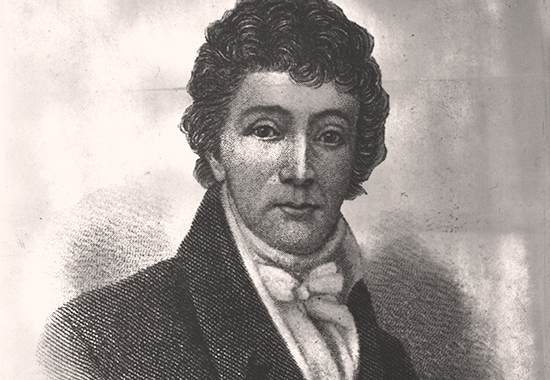
"The star-spangled banner - O long
may it wave"
Francis Scott Key 1779-1843
Francis Scott Key was a lawyer from
Maryland, and the author of the national anthem of the
United States, The Star-Spangled Banner.
|
|
Image Above
Francis Scott Key
Library of
Congress |
Key's family was financially comfortable. His parents owned
the large estate Terra Rubra at Keymar, then
Frederick County, today's Carroll County, Maryland.
Key's father,
John Ross Key, was a
well-known judge.
Key himself became a respected and
influential figure in the world of law and politics of his days. Although
a prolific writer, he is not remembered for his poems.
Francis Scott Key — Brief Biography
August 1, 1779 - Birth in Frederick
county, Maryland, U.S.

Terra Rubra, Keymar, Maryland — Birthplace of Francis Scott Key
1755, Keysville Bruceville Road, Keymar, Carroll County
The original mansion was torn down in the 1850s.
And yes, there were
outbuildings on the estate for slaves.
See also
 Land of the Free?
Land of the Free?
Photo: Wiki
|
1789 |
Grammar school |
| |
|
|
1796 |
Studies law at St. John's College
while working in his uncle's (Philip
Barton Key) law firm at
Annapolis |
| |
|
|
1801 |
Practices law at Frederick, Maryland |
| |
|
|
1802 |
Own
law practice in Georgetown, D.C. |
| |
|
|
January 19, 1802 |
Marries
Marie Tayloe "Polly" Lloyd. The couple will be "blessed" with 11 children
(6 sons, 5 daughters). |
| |
|
|
1805 |
Key
writes the lyrics of a song he
titles When the Warrior Returns from the Battle Afar. He
sets it to the exact same tune that he will be choosing for his 1814 song Defence of Fort M'Henry,
aka The Star-Spangled Banner.
It is the Anacreontic Song, also called
 To Anacreon in Heaven. To Anacreon in Heaven. |
| |
|
|
June 18, 1812 |
The
 War of 1812
begins
War of 1812
begins |
| |
|
|
September 13/14, 1814 |
British
 Bombardment of
Fort McHenry, part of
the Battle
of Baltimore (September
12-14,1814)
Bombardment of
Fort McHenry, part of
the Battle
of Baltimore (September
12-14,1814) |
| |
|
|
February 17, 1815 |
The
War of 1812
ends |
| |
|
|
1833 |
Key
becomes United States Attorney for
the District of Columbia |
| |
|
|
1835 |
U.S.
Attorney Francis Scott Key charges
the failed assassin of
 President
Andrew Jackson with
assault with intent to kill.
President
Andrew Jackson with
assault with intent to kill. |
| |
|
|
January 11, 1843 |
Death
at Baltimore while visiting his
daughter. The cause of death was
pleurisy, which is the inflammation
of the pleura, or lung lining. |
|

Pleura of the Lungs
(Lung Lining)
Copyright Nucleus Medical Art,
Inc. |
| |
|
| |
|
|
Post Mortem |
|
| |
|
|
1857 |
Publication of a collection of Key's
other poems. None of them
outstanding. |
| |
|
|
March 3, 1931 |
 President
Herbert Hoover signs
into law the bill H.R. 14, making
Key's song the national anthem of
the United States. Driving force
behind this bill were war veterans
and
Representative John Linthicum
of Maryland. This decision was not
undisputed. Some said the song was
difficult to sing due to its range
and its rather complicated lyrics.
Others disapproved of the fact that
the lyrics spoke of war.
President
Herbert Hoover signs
into law the bill H.R. 14, making
Key's song the national anthem of
the United States. Driving force
behind this bill were war veterans
and
Representative John Linthicum
of Maryland. This decision was not
undisputed. Some said the song was
difficult to sing due to its range
and its rather complicated lyrics.
Others disapproved of the fact that
the lyrics spoke of war. |
| |
|
|
1947 |
Key’s
Georgetown house, where he lived
with his wife Polly and his 11
children, was removed to make way
for a highway. |
| |
|
|
May 30, 1949 |
By a
joint resolution of Congress, a flag
flies continuously over a monument
marking Key's birthplace in Keymar, Maryland. |
Defence of Fort
M'Henry
After the
 Battle of Bladensburg on
August 24, 1814, in which the British routed the Americans, 65-year-old physician
Dr. William Beanes
of Upper Marlboro, Maryland, was captured by the British and
held onboard the HMS Tonnant in the Chesapeake Bay.
Battle of Bladensburg on
August 24, 1814, in which the British routed the Americans, 65-year-old physician
Dr. William Beanes
of Upper Marlboro, Maryland, was captured by the British and
held onboard the HMS Tonnant in the Chesapeake Bay.
Beanes was a friend of the Key family,
and 35-year-old Francis Scott Key obtained permission to try to negotiate Dr. Beanes' release from the
British.
On September 7, 1814, Key and the U.S.
deputy for prisoner exchange, Col. John
Skinner, boarded the
HMS Tonnant. After negotiations, British
Maj. Gen.
Robert Ross gave permission to release Beanes.
However, Key, Skinner, and Beanes were
ordered to stay put because the British were ready to commence their attack on
Baltimore.
A
bombardment of Fort McHenry, a fort protecting the harbor of
Baltimore, begun on September 13, 1814. Key was situated just a few
miles upriver from the fort.

Fort McHenry Today
Fort McHenry National Monument and Historic Shrine, Maryland
About 3 miles from the center of Baltimore, off U.S. 301 and Md. 2,
on East Fort Avenue;
address: 2400 East Fort Avenue Baltimore, MD
21230-5393.
Fort McHenry was first established in 1925 as a National Park and
redesignated by Congress in 1939 as a National Monument and Historic
Shrine.
It includes the pentagonal brick fort and surrounding area
of slightly more than 43 acres.
NPS.gov
After 25 hours of non-stop bombardment all through the night of
September 13-14, 1814, Key expected that the
fort was taken. However, the next morning he noticed that the
American flag was
still flying over Fort McHenry.
Then and there, with the tune of the
Anacreontic Song in mind, he scribbled down, on the back of
an envelope, the initial verse of a song he called
Defence of Fort M'Henry.
Here is the moment of inspiration:

The Star Spangled Banner
Francis Scott Key standing on boat, with right arm stretched out
toward the United States flag flying over Fort McHenry, Baltimore,
Maryland.
Percy Moran / Library of Congress
Back on land, Key polished and
finished his lyrics.
It was soon published by
the Baltimore Patriot, as mentioned, set to the tune of an English drinking
song, To Anacreon in Heaven.
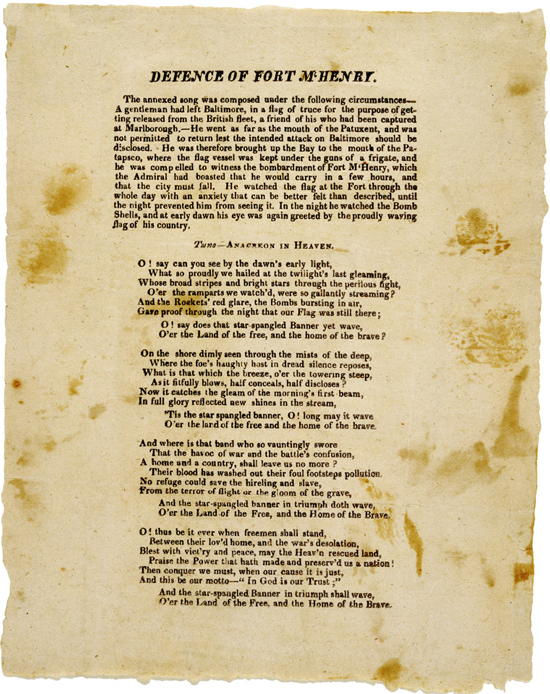
Defence of Fort McHenry
This is the first known printing of Key's poem.
Called a broadside, it was probably printed in Baltimore on Sept.
17, 1814.
Maryland Historical Society
The poem was published, everyone
already knew the tune, and its
patriotic sentiment got traction. Within weeks Key's song, soon
renamed The Star-Spangled Banner, appeared in newspapers up and down
the East Coast.
Here she goes:
The Star-Spangled Banner
O say can you see, by the dawn’s early light,
What so proudly we hail’d at the twilight’s last gleaming,
Whose broad stripes and bright stars through the perilous fight
O’er the ramparts we watch’d were so gallantly streaming?
And the rocket’s red glare, the bombs bursting in air,
Gave proof through the night that our flag was still there,
O say does that star-spangled banner yet wave
O’er the land of the free and the home of the brave?
On the shore dimly seen through the mists of the deep
Where the foe’s haughty host in dread silence reposes,
What is that which the breeze, o’er the towering steep,
As it fitfully blows, half conceals, half discloses?
Now it catches the gleam of the morning’s first beam,
In full glory reflected now shines in the stream,
’Tis the star-spangled banner - O long may it wave
O’er the land of the free and the home of the brave!
And where is that band who so vauntingly swore,
That the havoc of war and the battle’s confusion
A home and a Country should leave us no more?
Their blood has wash’d out their foul footstep’s pollution.
No refuge could save the hireling and slave
From the terror of flight or the gloom of the grave,
And the star-spangled banner in triumph doth wave
O’er the land of the free and the home of the brave.
O thus be it ever when freemen shall stand
Between their lov’d home and the war’s desolation!
Blest with vict’ry and peace may the heav’n rescued land
Praise the power that hath made and preserv’d us a nation!
Then conquer we must, when our cause it is just,
And this be our motto - "In God is our trust,"
And the star-spangled banner in triumph shall wave
O’er the land of the free and the home of the brave.
For more about the
 Attack of Fort
McHenry check this event in the timeline of the War of 1812.
Attack of Fort
McHenry check this event in the timeline of the War of 1812.
... and while we're at it:
To Anacreon in Heaven
Key's poem was set to the music of the
British song
To Anacreon in Heaven, also called The Anacreontic Song.
It was
composed around 1775 by John Stafford Smith and served as
the "constitutional song" of the Anacreontic Society, a gentlemen's
music club, founded in 1766, which met at the Crown and Anchor
tavern in the Strand, London.
Who was Anacreon?
An ancient Greek poet, who lived
around 582-485 BCE. Anacreon processed in his writing, among other
things and certainly more delicately than his successors, all
aspects of a good night out.
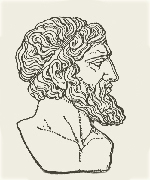
Anacreon
George J. Hagar / The Standard
American Encyclopedia / University of South Florida
Who was John Stafford Smith?
A musician from Gloucester, England.
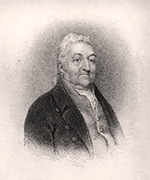
John Stafford Smith 1750-1836
Thomas Illman (after
William Behnes) / Copyright National Portrait Gallery, London
Oxford's Dictionary of National Biography says that Smith "almost certainly composed this song", which
is good enough for us.
Now, some say that this was a British
drinking song, others, who might or might not be patriotic purists,
say it was just a British song.
Here are the original lyrics, judge
for yourself. Bacchus, by the way, is the Greek god of wine,
ecstasy, and celebrations, which could perhaps serve as a hint.
1
To ANACREON in Heav'n, where he sat in full Glee,
A few Sons of Harmony sent a Petition,
That He their Inspirer and Patron wou'd be;
When this Answer arriv'd from the JOLLY OLD GRECIAN
"Voice, Fiddle, and Flute,
"No longer be mute,
"I'll lend you my Name and inspire you to boot,
"And, besides, I'll instruct you like me, to intwine
"The Myrtle of VENUS with BACCHUS's Vine.
2
The news through OLYMPUS immediately flew;
When OLD THUNDER pretended to give himself Airs_
If these Mortals are suffer'd their Scheme to pursue,
The Devil a Goddess will stay above Stairs.
"Hark! already they cry,
"In Transports of Joy
"Away to the Sons of ANACREON we'll fly,
"And there, with good Fellows, we'll learn to intwine
"The Myrtle of VENUS with BACCHUS'S Vine.
3
"The YELLOW-HAIR'D GOD and his nine fusty Maids
"From HELICON'S Banks will incontinent flee,
"IDALIA will boast but of tenantless Shades,
"And the bi-forked Hill a mere Desart will be
"My Thunder, no fear on't,
"Shall soon do it's Errand,
"And, dam'me! I'll swinge the Ringleaders I warrant,
"I'll trim the young Dogs, for thus daring to twine
"The Myrtle of VENUS with BACCHUS'S Vine.
4
APOLLO rose up; and said, "Pr'ythee ne'er quarrel,
"Good King of the Gods with my Vot'ries below:
"Your Thunder is useless_then, shewing his Laurel,
Cry'd. "Sic evitabile fulmen, you know!
"Then over each Head
"My Laurels I'll spread
"So my Sons from your Crackers no Mischief shall dread,
"Whilst snug in their Club-Room, they Jovially twine
"The Myrtle of VENUS with BACCHUS'S Vine.
5
Next MOMUS got up, with his risible Phiz,
And swore with APOLLO he'd cheerfull join_
"The full Tide of Harmony still shall be his,
"But the Song, and the Catch, & the Laugh shall bemine
"Then, JOVE, be not jealous
Of these honest Fellows,
Cry'd JOVE, "We relent, since the Truth you now tell us;
"And swear, by OLD STYX, that they long shall entwine
"The Myrtle of VENUS with BACCHUS'S Vine.
6
Ye Sons of ANACREON, then, join Hand in Hand;
Preserve Unanimity, Friendship, and Love!
'Tis your's to support what's so happily plann'd;
You've the Sanction of Gods, and the FIAT of JOVE.
While thus we agree
Our Toast let it be.
May our Club flourish happy, united and free!
And long may the Sons of ANACREON intwine
The Myrtle of VENUS with BACCHUS'S Vine.
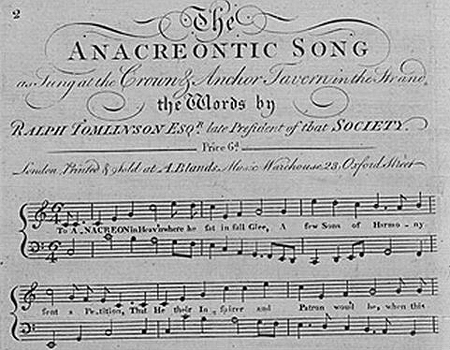
The Anacreontic Song
Words by Ralph Tomlinson, music by John Stafford Smith, about 1775.
Smithsonian
What Was the National
Anthem Before The Star-Spangled Banner?
The Star-Spangled Banner became
the official American national anthem in 1931. Before that, there
was no official national anthem.
Unofficially, The Star-Spangled
Banner was often used, during the Civil War for example, both,
the North and the South played and sang The Star-Spangled Banner.
It took
 World War I and renewed
patriotism to make this anthem official.
World War I and renewed
patriotism to make this anthem official.
Now, about that flag . . .
The Flag at Fort
McHenry
Fort McHenry was under the command of
Major George Armistead. Armistead himself had ordered the garrison's
flag from Mary Young Pickersgill, a Baltimore flag maker.
Ever so diligent in her business, Pickersgill had a government contract and was assisted by her
daughter, two nieces, and an indentured African-American girl.
The
flag had the
impressive proportions of 30 by 42 feet. All 15 stars measured two feet across,
and its 15 stripes had a width of two feet.
Was this the flag that flew during the attack on Fort McHenry?
Probably not. During the bombardment, the fort most likely raised
their 17 by 25 foot storm flag, also the work
of Mrs. Pickersgill.
 Check the delivery
date and price of the flags in the timeline of the War of 1812.
Check the delivery
date and price of the flags in the timeline of the War of 1812.
Storm flag raised or not, the flag that Key saw at
dawn on September 14, 1814, was the massive one.
Says militiaman
Isaac
Monroe of the Baltimore Fencibles,
Our morning gun was fired,
the flag hoisted, [and] Yankee Doodle played.
Today, this flag is one of the greatest
treasures of the Smithsonian’s National Museum of American History.

A conservator works on the
Star-Spangled Banner in 1914
Corbis / Smithsonian
Here is the flag of
1814 and the 1948 flag right next to each other.
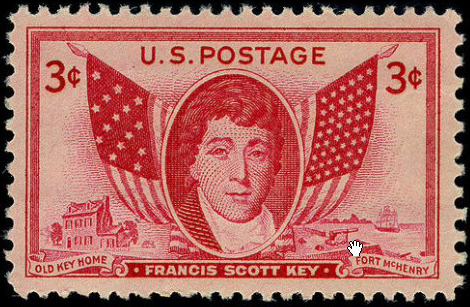
Key's Stamp
3 cent stamp honoring Francis Scott Key, issued August 9, 1948
illustrating Key's portrait, the old Key home, the flag of 1814, the
flag in 1948, and Fort McHenry
Smithsonian National Postal
Museum
Star-Spangled Banner
Trivia
Firstly, yes, that's a question mark at the end
of the first "home of the brave." It makes sense not being sure
while "bombs bursting in air."
Secondly, "the rockets' red glare" refers to Congreve rockets,
used by the British in the attack and
named after Sir William Congreve,
who had created the world's first rocket weapons system and
initiated the modern process of research and development in
rocketry.
This is Sir Congreve Jr.:
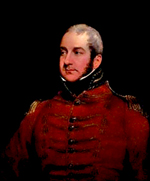
Sir William Congreve 1772-1828
Oil on
canvas by James Lonsdale, c.1812
Copyright
National Portrait Gallery, London
And this is one of
his rockets in action:

Congreve Rockets
The Congreve
rocket was used with a 16-foot guide stick for
stabilization. It had a range of 0.5 to 2 miles,
or 0.8 to 3.2 kilometers, depending on its size.
Charles Hubbell
/ NASA
Now, last but not least . . .
Francis Scott Key and
Slavery
Interesting tidbit here from the
Smithsonian Magazine, September 2004, Francis Scott Key, the
Reluctant Patriot, an article by Norman Gelb:
A religious
man, Key believed slavery sinful; he
campaigned for suppression of the slave
trade. “Where else, except in slavery,” he
asked, “was ever such a bed of torture
prepared?” Yet the same man, who coined the
expression “the land of the free,” was
himself an owner of slaves who defended in
court slaveholders’ rights to own human
property.
Key believed that the best solution was for
African-Americans to “return” to
Africa—although by then most had been born
in the United States. He was a founding
member of the American Colonization Society,
the organization dedicated to that
objective; its efforts led to the creation
of an independent Liberia on the west coast
of Africa in 1847. Although the society’s
efforts were directed at the small
percentage of free blacks, Key believed that
the great majority of slaves would
eventually join the exodus. That assumption,
of course, proved to be a delusion.
“Ultimately,” says historian Egerton, “the
proponents of colonization represent a
failure of imagination. They simply cannot
envision a multiracial society. The concept
of moving people around as a solution was
widespread and being applied to Indians as
well.”
Let's wrap it up with a quote from
Joseph Rodman Drake, a young
poet from New York City, who lived 1795-1820.
Forever float that standard sheet!
Where breathes the foe but falls before
us,
With Freedom’s soil beneath our feet,
And
Freedom’s banner streaming o’er us?
That's right.
Another question mark. Think about it.
And here is more
on
 Stars and Stripes
Stars and Stripes
More History
|